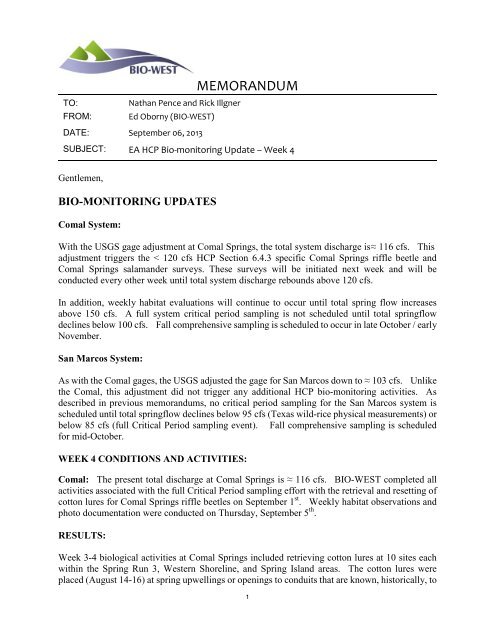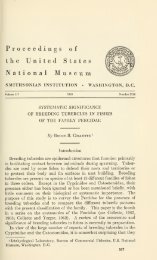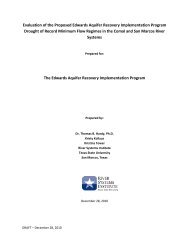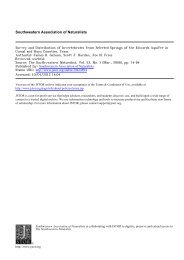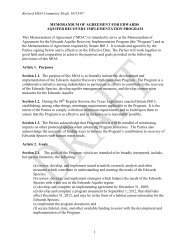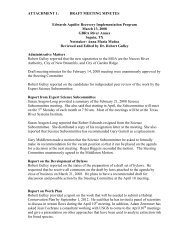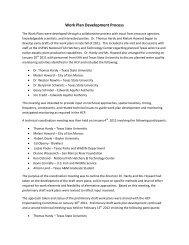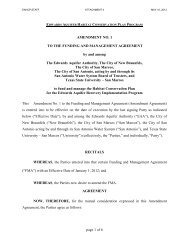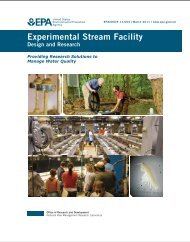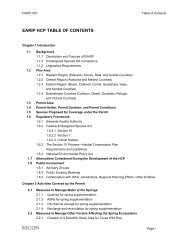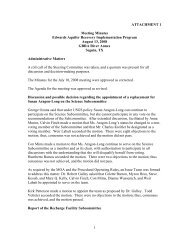Week 4: September 06, 2013, Biological Monitoring Report - EAHCP
Week 4: September 06, 2013, Biological Monitoring Report - EAHCP
Week 4: September 06, 2013, Biological Monitoring Report - EAHCP
Create successful ePaper yourself
Turn your PDF publications into a flip-book with our unique Google optimized e-Paper software.
MEMORANDUMTO:Nathan Pence and Rick IllgnerFROM: Ed Oborny (BIO-WEST)DATE: <strong>September</strong> <strong>06</strong>, <strong>2013</strong>SUBJECT: EA HCP Bio-monitoring Update – <strong>Week</strong> 4Gentlemen,BIO-MONITORING UPDATESComal System:With the USGS gage adjustment at Comal Springs, the total system discharge is ≈ 116 cfs. Thisadjustment triggers the < 120 cfs HCP Section 6.4.3 specific Comal Springs riffle beetle andComal Springs salamander surveys. These surveys will be initiated next week and will beconducted every other week until total system discharge rebounds above 120 cfs.In addition, weekly habitat evaluations will continue to occur until total spring flow increasesabove 150 cfs. A full system critical period sampling is not scheduled until total springflowdeclines below 100 cfs. Fall comprehensive sampling is scheduled to occur in late October / earlyNovember.San Marcos System:As with the Comal gages, the USGS adjusted the gage for San Marcos down to ≈ 103 cfs. Unlikethe Comal, this adjustment did not trigger any additional HCP bio-monitoring activities. Asdescribed in previous memorandums, no critical period sampling for the San Marcos system isscheduled until total springflow declines below 95 cfs (Texas wild-rice physical measurements) orbelow 85 cfs (full Critical Period sampling event). Fall comprehensive sampling is scheduledfor mid-October.WEEK 4 CONDITIONS AND ACTIVITIES:Comal: The present total discharge at Comal Springs is ≈ 116 cfs. BIO-WEST completed allactivities associated with the full Critical Period sampling effort with the retrieval and resetting ofcotton lures for Comal Springs riffle beetles on <strong>September</strong> 1 st . <strong>Week</strong>ly habitat observations andphoto documentation were conducted on Thursday, <strong>September</strong> 5 th .RESULTS:<strong>Week</strong> 3-4 biological activities at Comal Springs included retrieving cotton lures at 10 sites eachwithin the Spring Run 3, Western Shoreline, and Spring Island areas. The cotton lures wereplaced (August 14-16) at spring upwellings or openings to conduits that are known, historically, to1
e habitat for a variety of beetle species, including Comal Springs riffle beetle (Heterelmiscomalensis). During collections, the more common Elmid beetle, Microcylloepus pusillus wasthe most abundant beetle collected. Comal Springs riffle beetles and Peck's Cave amphipods(Stygobromus pecki) were also documented at each of the three representative study reaches(Spring Run 3, Western Shoreline, and Spring Island). As this was a 2-week preliminaryevaluation to assess presence/absence, computing density based on this sampling is notappropriate. The comprehensive sampling protocol requires a 4-week collection period to allowthe detritus and algae to build up on the cotton lures to attract invertebrates. As such, a 2-weekcount is not appropriate to compare directly to the 4-week densities. As for total counts, over adozen Comal Springs riffle beetles were found at both Spring Run 3 and Spring Island, and over 20individual riffle beetles were recorded from the Western Shoreline study reach. Next week (9-13<strong>September</strong>) we will be collecting our 4-week samples and will have density estimates to presentand compare to established baseline conditions.I have not included many photographs in this memorandum as conditions this week (Sept. 5 th )have changed very little from observations last week (August 28 th ). Spring runs 1 and 2 continueto be very low with little to no flow near the orifice and surface flow extended downstream in eachrun. Spring run 3 continues to maintain upwelling flow from the headwaters with surfaceconnectivity to the entire spring run. It was again visually evident that upwelling flow is stillcoming from the Upper Spring Run reach. Individual springs with upwelling flow were observednear the confluence of Blieders creek. Neither Spring Run 5 (Upper Spring run reach) nor eitherthe northern and southern runs of Spring Run 6 (Spring Island) had surface flow. Figure 1 showsthe upstream view from Spring Island with several upwelling springs still quite evident.Figure 1: Just upstream of Spring Island – numerous upwelling areas – shown by bubbles2
Similar to each memorandum this August, fountain darter habitat conditions in Landa Lake remainfavorable with multiple spring upwellings and large patches of bryophytes both on their own andlocated within other vegetation types. However, as noted last week, surface vegetation matscontinue to form (Figure 2). The City of New Braunfels has been notified of this potentialconcern and will be taking action to alleviate this risk.Figure 2: Extensive vegetation mats in Landa LakeIn addition to the lake, fountain darter habitat continues to prosper in the New Channel and OldChannel. As per the Section 6.3.4 of the HCP (< 150 cfs trigger), presence absence dip netting forthe fountain darter will next occur in October, or when total discharge declines below 100 cfs.In summary, the Comal system continues to support quality fountain darter habitat conditions inLanda Lake and Old and New Channels. Limited fountain darter habitat continues to persist inthe Upper Spring Run reach. As stated in previous weeks, impacts to endangered Comalinvertebrate surface habitat continue to occur in the Spring Island area as well as the main springruns. Sampling in the representative areas (Spring Run 3, Western Shoreline, and Spring Island)confirmed that Comal Springs riffle beetles are still occupying both horizontal and upwellinghabitats. Peck’s Cave amphipods were also documented in all three representative sample areas.To examine potential impacts of invertebrate populations in Spring runs 1 and 2, BIO-WEST willbe assisting the U.S. Fish and Wildlife Service (USFWS) Aquatic Resources Center (ARC)3
iologists set and retrieve cotton lures in the both Spring Run 1 and Spring Run 2. A portion ofthe riffle beetles collected will be transported by ARC biologists to the ARC for support of refugiapopulations. It should be noted that this is not a HCP required activity but rather a USFWS dutyrelating to refugia. As such, BIO-WEST is donating our time to support this activity (in an effortto collect data that will assess potential impact and subsequent recovery [should impact bedetected]) and will not be billing the Authority for these activities. The HCP bio-monitoring isdesigned specifically to address impacts and recovery at the three representative reaches (SpringRun 3, Western Shoreline, and Spring Island). However, it is possible that none of these threeareas will experience significant impacts during this drought, and as such collecting someinformation on Spring Run 1 that has already gone subsurface near the orifice seems prudent tomaximize the opportunity this current drought is providing.San MarcosAs previously mentioned, no critical period sampling activities have been triggered this summeron the San Marcos system. As discussed in last week’s memorandum and echoed at the<strong>September</strong> 3 rd drought contingency meeting, some impacts to aquatic habitat are occurring in theSan Marcos system but have not approached the magnitude witnessed in 2009.As always, please don’t hesitate to contact me if you have any questions or concerns.Ed4


